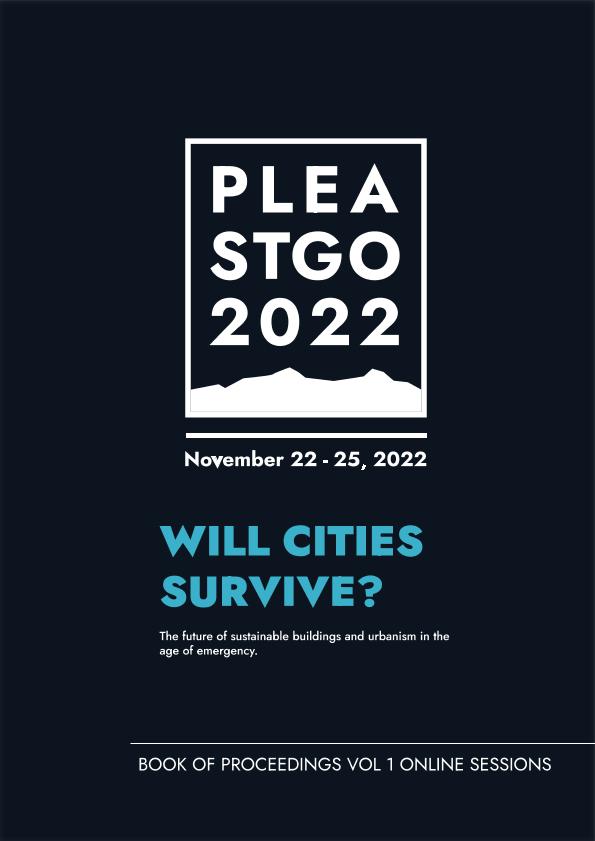Mostrar el registro sencillo del ítem
dc.contributor.author
Ruiz, Verónica Jimena

dc.contributor.author
Rodriguez, Roberto Germán

dc.contributor.author
Pattini, Andrea Elvira

dc.contributor.other
Bustamante, Waldo
dc.contributor.other
Andrade, Mariana
dc.contributor.other
Ortiz, Pablo E.
dc.date.available
2024-04-04T14:08:21Z
dc.date.issued
2022
dc.identifier.citation
Comparative overview of lighting credits from WELL environmental assessment method; Passive and Low Energy Architecture: Will cities survive? The future of sustainable buildings and urbanism in the age of emergency; Santiago de Chile; Chile; 2022; 768-772
dc.identifier.isbn
978-956-14-3068-6
dc.identifier.uri
http://hdl.handle.net/11336/231974
dc.description.abstract
Beyond an energy-centric perspective, Building Environmental Assessment Methods (BEAM) may contribute to the achievement of healthier indoor built environments, allowing building sustainability to reach its full potential as a public health transformation tool. The objective of this paper is to characterize WELL V2 by means of two-stage heuristic analysis method (i.e. based on expert criteria): (i) a qualitative screening based on seven dimensions of analysis and (ii) a 0-100 quantitative assessment of nine dimensions of analysis. Our first stage results showed that WELL fulfilled all of the proposed criteria for other more established BEAM. Stage two results showed an overall score of 68, below LEED and BREEAM scores from the literature, and above CASBEE, HK-BEAM, and GREENSTAR. In terms of applicability, WELL lacks of lifecycle related criteria. WELL V2 showed a good comparative performance among BEAMs, placing it as a seminal method for the creation of new and more suitable wellbeing and health labelling systems, mimicking the role BREEAM played at the end of the 20th century. KEYWORDS: Integrative Lighting, Environmental Assessment Method, Overview
dc.description.abstract
Beyond an energy - centric perspective, Building Environmental Assessment Methods (BEAM) may contribute to the achievement of healthier indoor built environments, allowing building sustainability to reach its full potential as a public health transformation too l. The objecti ve of this paper is to characterize WELL V2 by means of two -stage heuristic analysis method (i.e. based on expert criteria): (i) a qualitative screening based on seven dimensions of analysis and (ii) a 0 -100 quantitative assessment of nine dimensions of an alysis. Our first stage results showed that WELL fulfilled all of the proposed criteria for other more established BEAM. Stage two results showed an overall score of 68, below LEED and BREEAM scores from the literature, and above CASBEE, HK-BEAM, and GREEN STAR. In terms of applicability, WELL lack s of lifecycle related criteria. WELL V2 showed a good comparative performance among BEAMs, placing it as a seminal method for the creation of new and more suitable wellbeing and health labelling systems, mimicking the role BREEAM played at the end of the 20th century.
dc.format
application/pdf
dc.language.iso
eng
dc.publisher
Passive and Low Energy Architecture
dc.rights
info:eu-repo/semantics/openAccess
dc.rights.uri
https://creativecommons.org/licenses/by-nc-sa/2.5/ar/
dc.subject
LIGHTING
dc.subject
ENVIRONMENTAL ASSESSMENT mETHOD
dc.subject
OVERVIEW
dc.subject.classification
Otras Ingenierías y Tecnologías

dc.subject.classification
Otras Ingenierías y Tecnologías

dc.subject.classification
INGENIERÍAS Y TECNOLOGÍAS

dc.title
Comparative overview of lighting credits from WELL environmental assessment method
dc.type
info:eu-repo/semantics/publishedVersion
dc.type
info:eu-repo/semantics/conferenceObject
dc.type
info:ar-repo/semantics/documento de conferencia
dc.date.updated
2023-11-01T15:34:36Z
dc.journal.volume
1
dc.journal.pagination
768-772
dc.journal.pais
Chile

dc.journal.ciudad
Santiago de Chile
dc.description.fil
Fil: Ruiz, Verónica Jimena. Consejo Nacional de Investigaciones Científicas y Técnicas. Centro Científico Tecnológico Conicet - Mendoza. Instituto de Ambiente, Hábitat y Energía; Argentina
dc.description.fil
Fil: Rodriguez, Roberto Germán. Consejo Nacional de Investigaciones Científicas y Técnicas. Centro Científico Tecnológico Conicet - Mendoza. Instituto de Ambiente, Hábitat y Energía; Argentina
dc.description.fil
Fil: Pattini, Andrea Elvira. Consejo Nacional de Investigaciones Científicas y Técnicas. Centro Científico Tecnológico Conicet - Mendoza. Instituto de Ambiente, Hábitat y Energía; Argentina
dc.relation.alternativeid
info:eu-repo/semantics/altIdentifier/url/https://plea2022.org/wp-content/uploads/2023/03/PROCEEDING-ONLINE-FINAL-MARZO.pdf
dc.conicet.rol
Autor

dc.conicet.rol
Autor

dc.conicet.rol
Autor

dc.coverage
Internacional
dc.type.subtype
Conferencia
dc.description.nombreEvento
Passive and Low Energy Architecture: Will cities survive? The future of sustainable buildings and urbanism in the age of emergency
dc.date.evento
2022-11-22
dc.description.ciudadEvento
Santiago de Chile
dc.description.paisEvento
Chile

dc.type.publicacion
Book
dc.description.institucionOrganizadora
Passive and Low Energy Architecture
dc.description.institucionOrganizadora
Centro de Desarrollo Urbano Sustentable
dc.description.institucionOrganizadora
Pontífica Universidad Católica de Chile. Facultad de Arquitectura, Diseño y Estudios Urbanos
dc.description.institucionOrganizadora
Universidad de Concepción
dc.description.institucionOrganizadora
Agencia Nacional de Investigación y Desarrollo
dc.source.libro
Will cities Survives? The future of sustainable buildings and urbanism in the age of emergency
dc.date.eventoHasta
2022-11-25
dc.type
Conferencia
Archivos asociados
